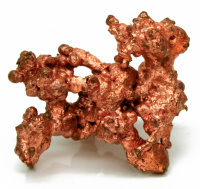copper
Copper (cuprum) is a chemical element in the Periodic Table of Elements that has the symbol Cu and proton number 29. Copper is a noble non-alotropic metal with a cubic, face-centered crystal system, red in color. It has high thermal conductivity, hot and cold formability and good corrosion resistance.
Properties of copper
Some other mechanical properties
yield strength – 60 MPa
ultimate strength - 220 MPa (relatively soft)
ductility - 50%
contraction - 70%
Corrosion resistance
The good corrosion resistance of copper is caused by two factors:
positive electrochemical potential +0.34 V,
the effects of oxides and other compounds that form on its surface.
Copper is protected against atmospheric corrosion by a layer of hydrated copper carbonates. It also has good resistance in acid solutions without oxidizing effects (hydrochloric acid, hydrofluoric acid) if they are not aerated. Chlorine, ammonia and sulfur compounds have an adverse effect on copper.
Hydrogen disease of copper
If copper contains more than 0.03% oxygen, it is prone to cracking. At temperatures above 400 °C, hydrogen diffuses from the gaseous atmosphere into the copper and reacts according to the equation:
Cu2O + H2 → 2 Cu + H2O
Water vapor creates internal pressures in the copper causing cracks and voids.
Use of copper
Copper is used for technical purposes both as a pure metal (about 55% of production) and as an alloy with various elements (the rest). Up to 75% of copper products are used in electrical engineering, followed by engineering, food and chemical industry. It is used, for example, in the production of wires, sheets, pipes and coins, in agriculture to treat crop diseases, to protect wood, leather and tissues. Due to its high electrical and thermal conductivity, it is also used as a metabolite. Common copper salts such as sulfate, carbonate, cyanide, oxide, and sulfide are used as a fungicide, an ingredient in ceramics and pyrotechnics, for electroplating, and other industrial applications. Alloys of copper, bronze and brass are used for the production of devices and tools in various industries.
Technical copper
raw metallurgical copper contains only 94 to 97% Cu,
metallurgical copper can reach a purity of up to 99.85% Cu, it is produced by pyrometallurgical refining of raw metallurgical copper,
electroconductive copper or cathode copper reaches up to 99.95% Cu, produced by electrolytic refining,
the purest copper containing up to 99.999% Cu is produced by vacuum refining from cathode copper,
oxygen-free copper, resistant to hydrogen sickness, is used especially for welding
Copper alloys
Copper alloys form two main groups:
brasses – copper alloys with zinc as the main ingredient,
bronzes - alloys of copper with tin, aluminum, lead as the main ingredients.
Copper compounds
The most common compounds are copper oxide, copper oxide, and copper sulfide. It is part of ores (e.g. chalcopyrite CuFeS2, chalcosine Cu2S, cuprite Cu2O and malachite CuOH2.CuCO3).
Biological significance
Copper is an essential element for all higher plants and animals. After absorption in the digestive system, it binds to albumin and is transported to the liver. In the blood, it binds to the plasma protein ceruloplasmin.
It is part of various enzymes, in the form of copper centers in cytochrome-C oxidase and in superoxide dismutase (contains copper and zinc). In addition to its role in enzymes, copper is used for biological electron transport. Blue copper proteins that participate in electron transport include, for example, azurin and plastocyanin. The name "blue copper" comes from the intense blue color resulting from ligand-to-metal charge transfer (LMCT), the absorption band of the complex is around 600 nm.
Zinc and copper are likely to compete for absorption in the digestive tract, so a diet high in one of these minerals may be deficient in the other.The recommended daily allowance of copper for healthy adults is 0.9 mg/day.
Toxicity
All copper compounds, unless otherwise known, should be considered toxic. The fatal dose of copper sulfate for humans is approximately 7 to 10 grams [1]. Copper is the third most abundant trace element in the body after zinc and iron. The suggested safe concentration in drinking water for humans varies by source, but tends to stabilize between 1.5 and 2 mg/L.Dietary reference intake: the tolerable upper limit of dietary copper consumption for adults from all sources is 10 mg/day.
An important part of the toxicity of copper comes from its ability to accept and donate electrons when changing its oxidation state. This catalyzes the formation of highly reactive radical ions, such as the hydroxyl radical, in a manner similar to the Fenton reaction. This catalytic activity is used by enzymes with which copper is normally associated and is therefore toxic only if it is separated and unmediated. This increase in the amount of unmediated free radicals is called oxidative stress and is the subject of active research in various diseases where copper may play an important but less important role than in acute toxicity.























































































































































